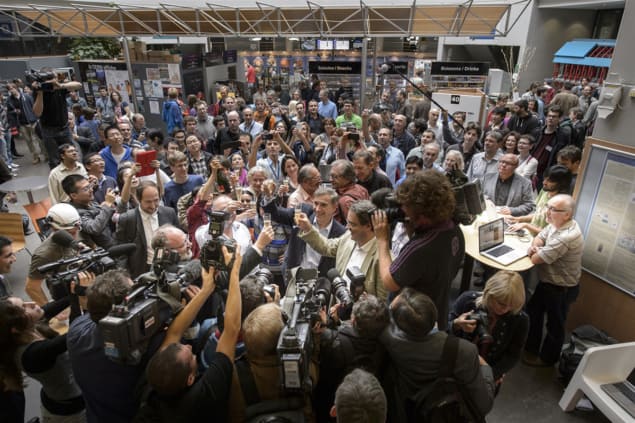
This year’s Nobel Prize for Physics will be announced in just a few days’ time and it is possible that the award committee is still arguing over who will win the prize. The only thing that can be said with certainty is that no more than three people will bag the award this year – and this is a big challenge for the committee in the current era of collaborative science.
Many physicists, and indeed most people in the working world, understand the power of collaboration. From working groups to technical teams, most scientific breakthroughs today are the result of groups of people working together toward a common goal. No better example of this can be found in the circumstances surrounding the 2013 Nobel Prize for Physics, which was awarded for the discovery of the Higgs mechanism.
The prize was bagged by Peter Higgs and François Englert, who predicted the existence of the mechanism way back in 1964. However, is wasn’t until CERN’s 2012 announcement that physicists working on the Large Hadron Collider (LHC) had observed the Higgs boson, that speculation intensified about who would win the inevitable Nobel prize for the Higgs.
Choosing three from thousands
At CERN, the Higgs was detected by two LHC experiments – CMS and ATLAS – which involved thousands of physicists around the world. So, how could the Nobel committee recognize this achievement with a prize that can only be awarded to a maximum of three people?
Instead of the experimentalists, the committee chose to focus on the scientists who made the theoretical prediction in the 1960s. But even then there were more than three to choose from. The “Higgs six” who made major contributions in 1964 were Higgs, Englert, Robert Brout, Carl Hagen, Gerald Guralnik and Tom Kibble (Philip Anderson is also included by some). Sadly, Brout had died in 2011—so the committee had five people to chose from. Exactly why they chose Higgs and Englert over the other three will remain a secret until 2063, when documents related to the decision will be released to the public.
Indeed, it can be difficult to pinpoint who was the first to do something in science. Even original thinkers like Isaac Newton admit that they are “standing on the shoulders of giants,” when doing their research. And having a ubiquitous particle named after you is no guarantee of a Nobel.
No prize for namesake
The Higgs particle is a boson, which is any particle that has an integer value of quantum spin. The Boson was named by Paul Dirac to recognize the Indian physicist Satyendra Nath Bose, who along with Albert Einstein developed the theory of bosons in the 1920s. But unlike Peter Higgs, Bose did not win a Nobel prize for this very important contribution to physics (neither did Einstein, but he already had a prize by then).
The obvious way to recognize the collaborative nature of science would be to award the prize to a group or organization. This practice is already followed by the Nobel Peace Prize, which has been awarded to the International Red Cross, United Nations and other organizations.

Who will win the Nobel Prize for Physics? Our predictions for 2023
While the physics prize has yet to embrace large collaborations, there was intense speculation in 2013 that the Higgs prize would mark a break with the three person rule. Lars Brink, a Swedish particle physicist and chair of the Nobel Committee for Physics in 2013, shed light on why it didn’t break the rule when he told Physics World in 2019, “we don’t want 5000 people calling themselves Nobel laureates”.
But why not recognize the thousands of physicists who built and operated the amazing machines that first detected the Higgs boson? Cosmologist Brian Keating argues that the three-person restriction is bad for the public understanding of science because it suggests that breakthroughs are made by “one or two lone geniuses – usually white males – working without vast support networks behind them”. In a time where investment in science is so important, perhaps it is prudent to show that science is done by a wide range of people.
The discovery of the Higgs mechanism should become a symbol of how science is done in the modern age – often over long periods of time and by many people. A century ago, lone recipients of the prize such as Einstein where appropriate when individuals were in the position to make breakthrough discoveries on their own. More recently, the advancement of knowledge has relied on large collaborations and perhaps it’s time that the Nobel Prize reflects that.
- SEO Powered Content & PR Distribution. Get Amplified Today.
- PlatoData.Network Vertical Generative Ai. Empower Yourself. Access Here.
- PlatoAiStream. Web3 Intelligence. Knowledge Amplified. Access Here.
- PlatoESG. Carbon, CleanTech, Energy, Environment, Solar, Waste Management. Access Here.
- PlatoHealth. Biotech and Clinical Trials Intelligence. Access Here.
- Source: https://physicsworld.com/a/nobels-three-winner-limit-does-not-reflect-modern-science/



